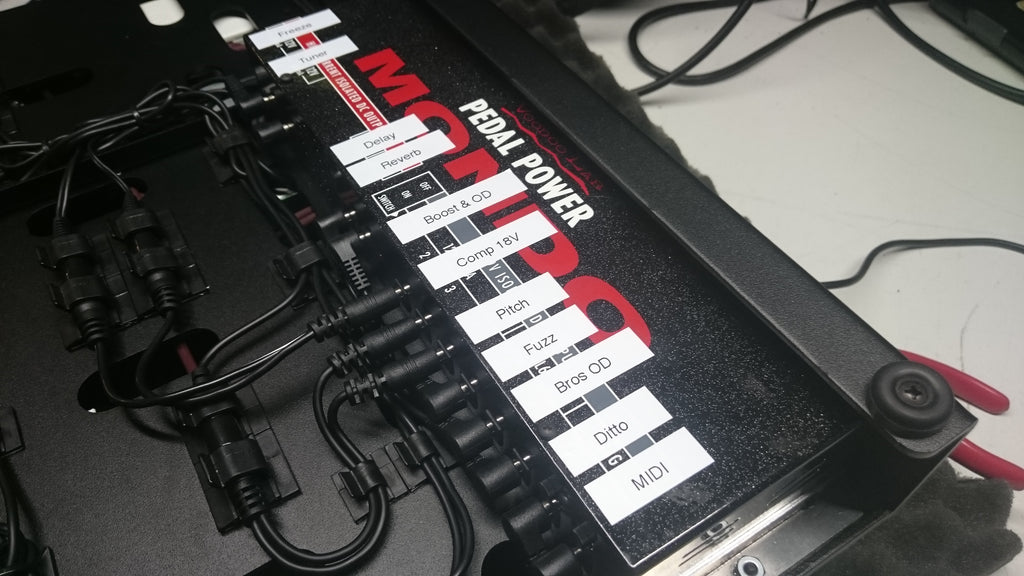How do I split power supply output for two or more pedals?
Instead of buying a second power supply unit (PSU), you can use careful planning to make the most of your existing power supply.
Power supply manufacturers offer a wealth of different splitter and merger cables, which is a real plus for pedalboard builders. Special adapter cables allow you to combine or split the outputs to run more pedals than you’d originally would have thought be possible. Instead of having to shell out for a second power supply, you can often achieve a hum-free sharing of power supply outputs without ground loops.
Different Adapter Cable Types
Voodoo Lab offers adapter cables for plugging into the PSU’s outputs. All Voodoo Lab adapter cables also work with Strymon power supplies.
Cioks offers similar adapter cables suitable for their power supply’s RCA-type outputs.
The adapter cable’s output is connected to the pedals using a standard pedal power cable. All adapter outputs are best connected to a straight plug, so you can secure the connection neatly with a piece of electrical tape and attach it with two pieces of 26 mm Custom Boards Safety Clips.

The most common power supply splitting scenarios:
1. Sharing one power supply output between two effects.
2. Combining two power supply outputs to run current-hungry pedals.
3. Doubling the voltage for 18 or 24 volt effects.
4. Daisy chaining several pedals to a single power supply output.
1. Sharing one PSU output between two effects
A single isolated output can be split for use with two pedals without causing an earth loop or buzzing. The output voltage remains unchanged, but the splitter cable will split the available current (mA) between the two effects.
Voodoo Lab Output Splitter adapter features one grounded output, with the other ground-lifted, meaning the second pedal is connected to earth via the guitar cable. This means the connection is only active when the pedal is plugged into the signal chain. Cioks’ similar adapter doesn’t offer an ungrounded output, but in practice we have only very seldom run into any noise problems using this adapter on our pedalboards.
Understanding the ground connection:

- The picture above shows you a Voodoo Lab Output Splitter adapter cable feeding nine volts to a pair of pedals (1 & 2).
- Only the supply cable for effect 1 is connected to ground.
- Effect 2, which is connected to the ground-lifted cable with white stripes, is only activated when a patch cable is connected to its input.
- For this effect the ground connection is only via the guitar cable, preventing a ground loop.
What pedals to split and what not?
This type of output splitting works best with gain pedals, compressors and boosters, as long as both effects use the same voltage and are connected with the same polarity. When planning to split an output, you should first calculate the combined current draw of both pedals to make sure you don’t overload the power supply.
Let’s say you’re splitting a 100 mA output. If your overdrive draws 10-20 mA and your compressor needs 20 mA to function, you’re well on the safe side with their combined maximum draw of 40 mA.
Trying to split one power supply output between different types of effects can sometimes give you trouble in the form of audible noise:
- The LFO-frequency of some modulation effects sometimes leaks into the shared DC supply, causing audible pulsation or modulation noises in the guitar signal.
- You can also run into trouble with digital effects running at differing internal clock rates.
- The third group of pedals that can make output splitting problematic are pedals that use internal voltage doubling. Such effects run on 18 volts internally, which will lead to audible interference when combined with a standard 9 V pedal.
In other words: Successful power splitting is not only dependent on the current draw of the combined pedals, but also on signal interference. This means it is important to always test the pedal combination for any extraneous noise before you install it on your board.
Checking for power split problems
After checking for induced hum you should next take a close look at each pedal’s power feed.

Splitting power supply outputs usually works best with gain pedals, wahs, compressors and boosters, as long as they require the same voltage and polarity. We have already taken into account the power draw of the effects during our planning phase. Now we want to make sure that feeding two pedals from one power supply output doesn’t result in any problems with the audio signal.
- Hook up the two pedals in question to your guitar and amp in series, meaning the output of the first effect feeds the input of the second pedal.
- With the effects on, listen for any buzzing or humming in the audio signal. Does the noise level improve when you swap the PSUs Y-cable’s plugs between the two effect pedals?
If you hear any added noise, you may have to look for another way of connecting your pedals to the power supply. We have zero noise tolerance at Custom Boards, but if the noise is quiet enough not to bother you, you may proceed to the next phase.
2. Combining two power supply outputs to run current-hungry pedals
Two outputs can be combined to deliver more current (mA) to a pedal. With more and more digital effects on the market there is a growing need for such combinations. In this case the voltage remains unchanged, but the output of two power supply outputs is combined to double the available current. These adapter cables are called current doublers. For example, by combining two nine volts outputs that deliver 100 mA each the current doubler will output nine volts and 200 mA.
3. Doubling the voltage for 18 or 24 volt effects
More available voltage opens up a wealth of additional possibilities for pedal effect designers. Even though a certain pedal might run on nine volts, too, it could have been designed to make good use of the additional voltage. Such advantages are often a more transparent-sounding, more dynamic pedal with additional signal headroom. Fulltone OCD is a great example of pedal design that can really benefit of using 18 volts.

A voltage doubler adapter is used to connect two nine volt PSU outputs into a single output with twice the voltage (18 volts). This voltage doubling also works with reverse polarity outputs and 2.5 mm connectors.
Disaster Area offer special converter box that achieve voltage doubling utilizing only a single nine volt power supply output. This box draws a little current to do it's job, which means that it can deliver up to 100 mA maximum current output.

Please note that a voltage doubler cable doesn’t change the PSU output’s current. Combining two nine volt, 100 mA outputs results in a single 18 volt output delivering 100 mA.
4. Daisy chaining several pedals to a single PSU output
Same as with output splitter cables, daisy chain cables also only work correctly when all pedals run on the same voltage and with the same DC polarity.

Daisy chain cables make it possible to run several effect pedals using a single PSU output. You should note, though, that with any additional daisy chained pedal the danger of audible noise in your signal grows. Daisy chain cables are one of the most common causes for a noisy pedalboard. Such a cable can lead to ground loops between the pedals connected to it, which will cause a steady hum. The reason for this type of ground loop is that the daisy chained pedals have contact to earth both via the PSU and the guitar cable.
But ground loops aren’t the only problem. In some cases buzz or hum can occur, even if the daisy chain cable is ground-lifted. In these cases the root of the problem are usually two (or more) digital pedals, whose clock rates are out of sync, which produces interference whenever they’re connected to a single power output. Clock rate interference mostly produces high-pitched buzz or squealing.
Using a daisy chain cable in combination with a Voodoo Lab Output Splitter
Despite offering several outputs some power supplies are only equipped with a single transformer, which means that all outputs share the same earth connection. When using all outputs to run a number of pedals with one cable each, you can experience a ground loop. But because all outputs are using the same transformer it is possible to use a single output to deliver the same voltage and the PSU’s combined current.
You can get creative and use a Voodoo Lab Output Splitter's ground-lifted cable with a daisy chain cable creatively to power a row of pedals without the risk of having a ground loop.
First you plug in the Output Splitter into one of the PSU’s outputs. Next you connect the Output Splitter's earthed output to the first effect. Then plug in the daisy chain cable into the ground-lifted output (the one with the white striped cable), and hook up the rest of the pedals to the daisy chain.

An example: If you’ve got a seven-plug daisy chain cable you can use it to connect pedals 2-8. These pedals (2-8) will only be powered once you’ve plugged the guitar cable into the first effect. The guitar cable will provide the required ground contact. Unplugging your guitar from the first pedal will cut the power for all other effects, too.
A ground loop is avoided thanks to only the first effect being connected to both the ground in the guitar cable and the ground in the power supply, while all other effects are only grounded via the guitar cable.
*****
If you have purchased all the parts and components but get a feeling that you might not be up to the task after all, we can make your pedalboard for you, using the components you have bought from us. Don’t worry, we won’t let anything go to waste.


